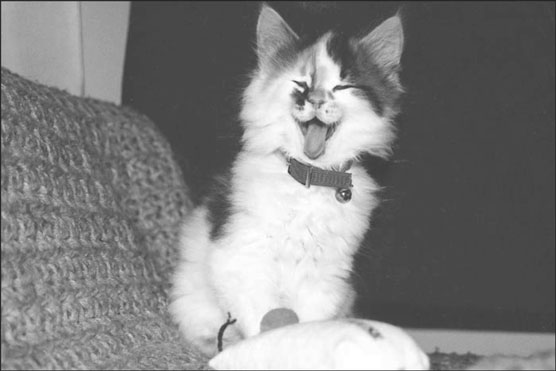Don’t fall in love with a sick cat. With so many kittens and cats available for adoption, it just doesn’t make sense to take a chance on one who may cost you a great deal of money in veterinary costs—and may not be with you long, anyway.
The outer cat
General impressions are important. Sure, all kittens are adorable, as you can see in the following figure, but you should get a sense of good health and vitality from the animal you’re considering adopting. He should feel good in your arms: neither too thin nor too fat, well put-together, sleek, and solid. If ribs are showing or the animal is potbellied, he may be suffering from malnutrition or worms — both fixable, but signs of neglect that may indicate deeper problems with socialization or general health.With soothing words and gentle caresses, go over the animal from nose to tail, paying special attention to the following areas:
- Fur and skin: Skin should be clean and unbroken, covered thickly with a glossy coat of hair. Bald patches may mean ringworm, not a parasite but a fungal infection that you can catch, too. Part the hairs and look for signs of fleas: The parasites themselves may be too small and fast for you to spot, but their droppings remain behind. If you’re not sure, put the cat on a clean surface, such as a stainless-steel counter or white towel and run your fingers against the grain. Then look on the surface: If fleas are present, you see the droppings as little bits that look like pepper. If you add water to them, they turn reddish in color — because they’re made up of dried blood. You shouldn’t count a cat out because of a few fleas, but a severe infestation could be a sign of a health problem, especially for kittens. (Some kittens become anemic from having so much of their blood sucked by the pests.)
- Ears: These should be clean inside or, perhaps, have a little bit of wax. Filthy ears and head-shaking are signs of ear mites, which can require a prolonged period of consistent medication to eradicate.
- Eyes: Eyes should look clear and bright. Runny eyes or other discharge may be a sign of illness. The third eyelid, a semitransparent protective sheath that folds away into the corners of the eyes nearest the nose (also called a haw), should not be visible.
- Nose: Again, the cat should have no discharge. The nose should be clean and slightly moist. A kitten or cat who is breathing with difficulty, coughing, or sneezing may be seriously ill.
- Mouth: Gums should be rosy pink, not pale, and with no signs of inflammation at the base of the teeth. The teeth should be white and clean of tartar buildup.
- Tail area: Clean and dry. Dampness or the presence of fecal matter may suggest illness.
 Abigail/Photo by Linda M. Seals
Abigail/Photo by Linda M. SealsLook beyond the pretty face for signs of good health and temperament.
Even though we believe you’re best off finding the healthiest, best-socialized cat or kitten you can, we do applaud those who take on the challenges of the neediest. Gina’s friend, Jan, for example, lives happily with a houseful of some of the weirdest cats imaginable. One of the newest additions to her home is Mimi (short for Screaming Mimi, to give you an idea of this cat’s worst trait). Jan found Mimi trapped in a drain pipe, a half-starved, seriously dehydrated kitten with ear mites, fleas, and worms. The veterinarian told Jan she didn’t think the kitten would make it, but Mimi pulled through and grew to be a sleek and glossy adult. Not that anyone would know, for Mimi hides from company. But she’s an affectionate companion to the woman who saved her life.
The inner cat
In the best circumstances, your kitten or adult cat will come with a clean bill of health certified by the shelter or other placement service, or vouched for by the cat’s own health records kept by the person trying to place him. If that’s not the case, you need to have any adoption prospect checked out by a veterinarian for serious problems you can’t see. Following are some problems you should have your pet checked for:- Infectious diseases: Feline leukemia is the biggest concern. Though many cats live with the virus well enough for years, you may want to consider carefully the added worry and health-care expense of owning such a cat. Then, too, if you already have cats, you may want to safeguard their health by not exposing them to the contagious virus. Your veterinarian can determine the presence of infectious disease with a simple test, and explain to you the results — and your options.
- Parasites: Worms are the biggest problem. Your veterinarian needs to verify their presence and prescribe an appropriate course of treatment.
Don’t put the cats you already have at risk by introducing a sick animal into your home. Have your new cat cleared by your veterinarian before you bring him home. Dr. Lauren recommends a short quarantine even if the kitten looks healthy, as least until you can discuss with your veterinarian what treatments or testing should be done.

